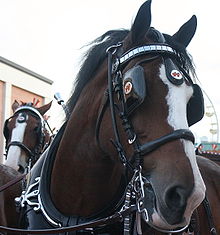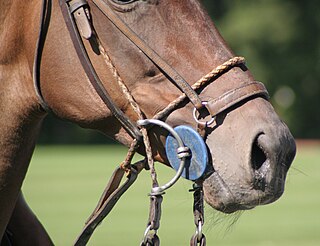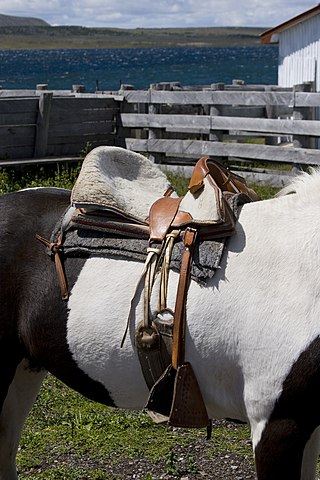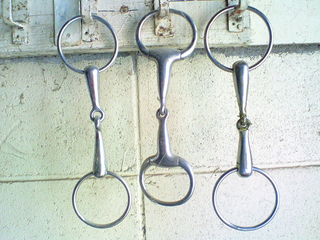

Blinkers, sometimes known as blinders, are a piece of horse tack that prevent the horse seeing to the rear and, in some cases, to the side. [1]


Blinkers, sometimes known as blinders, are a piece of horse tack that prevent the horse seeing to the rear and, in some cases, to the side. [1]
This section needs additional citations for verification .(September 2015) |
Blinkers are usually made of leather or plastic cups placed on either side of a horse's eyes - attached either to a bridle or to an independent hood. Blinkers that have a peep hole cut in the back of the cup are known as visors. [2] Many racehorse trainers believe that blinkers keep horses focused on what is in front, encouraging them to pay attention to the race rather than to distractions such as crowds. Additionally, driving horses commonly wear blinkers to keep them from being distracted or spooked, especially on crowded city streets. Most equestrian disciplines, other than racing and harness competition, do not permit the use of blinkers at any time, under penalty of elimination. In racing, blinkers are usually seen attached to a synthetic hood placed under the bridle. In driving, they are attached to the bridle's cheekpieces.
This section needs additional citations for verification .(September 2015) |

Sometimes, a "set of winkers" can refer to blinders, [3] but winkers may also refer to a related item of tack, usually fleece tubes, that are placed on the cheekpieces of a bridle and work similarly to a shadow roll to limit a horse's range of rear vision. They do not restrict the horse's view as much as blinkers do.
In Australian thoroughbred horse racing, winkers, (fleece rolls that are placed around the bridle cheek straps) may be used. Also used in Australian racing are "pacifiers," which are a blinker-style hood with mesh eye-covers, thought by some to calm horses. They may be banned from use on wet days as they may clog up with mud.
In the United Kingdom, a bag or cloth blindfold put over the head of a difficult horse while it is being handled (for example loaded into starting gates or mounted) is called a blinder. [4]
Both "blinker" and "blinder" are also used metaphorically to refer to people with an overly narrow focus or inability to see the larger picture. The term can be seen as implying "a limitation or obstruction to sight or discernment". [5]
Tack is equipment or accessories equipped on horses and other equines in the course of their use as domesticated animals. This equipment includes such items as saddles, stirrups, bridles, halters, reins, bits, and harnesses. Equipping a horse is often referred to as tacking up, and involves putting the tack equipment on the horse. A room to store such equipment, usually near or in a stable, is a tack room.

A bridle is a piece of equipment used to direct a horse. As defined in the Oxford English Dictionary, the "bridle" includes both the headstall that holds a bit that goes in the mouth of a horse, and the reins that are attached to the bit.

A halter or headcollar is headgear that is used to lead or tie up livestock and, occasionally, other animals; it fits behind the ears, and around the muzzle. To handle the animal, usually a lead rope is attached. On smaller animals, such as dogs, a leash is attached to the halter.
The Australian and New Zealand punting glossary explains some of the terms, jargon and slang which are commonly used and heard on Australian and New Zealand racecourses, in TABs, on radio, and in the horse racing media. Some terms are peculiar to Australia, such as references to bookmakers, but most are used in both countries.

Longeing or lungeing is a technique for training and exercising horses. It is also a critical component of the sport of equestrian vaulting.

A noseband is the part of a horse's bridle that encircles the nose and jaw of the horse. In English riding, where the noseband is separately attached to its own headstall or crownpiece, held independently of the bit, it is often called a cavesson or caveson noseband. In other styles of riding, a simple noseband is sometimes attached directly to the same headstall as the bit.

A snaffle bit is the most common type of bit used while riding horses. It consists of a bit mouthpiece with a ring on each side and acts with direct pressure. A bridle utilizing only a snaffle bit is often called a "snaffle bridle", particularly in the English riding disciplines. A bridle that carries two bits, a curb bit and a snaffle, or "bradoon", is called a double bridle.

The gag bit is a type of bit for a horse. Because the cheek piece and reins attach to different rings there is leverage action. Severity of leverage action depends on where the reins attach. For example, in a Dutch Gag, the further the rein attachment from the mouthpiece the greater the leverage. The gag bit is related to a Pelham bit and a double bridle but the gag bit has no curb strap.

A crupper is a piece of tack used on horses and other equids to keep a saddle, harness or other equipment from sliding forward.

Reins are items of horse tack, used to direct a horse or other animal used for riding. They are long straps that can be made of leather, nylon, metal, or other materials, and attach to a bridle via either its bit or its noseband.
Blinder or Blinders may refer to:

A girth, sometimes called a cinch, is a piece of equipment used to keep the saddle in place on a horse or other animal. It passes under the barrel of the equine, usually attached to the saddle on both sides by two or three leather straps called billets. Girths are used on Australian and English saddles, while western saddles and many pack saddles have a cinch, which is fastened to the saddle by a single wide leather strap on each side, called a latigo.

A bearing rein, known today as an overcheck or a checkrein, is a piece of horse tack that runs from a point on the horse's back, over the head, to a bit. It is used to prevent the horse from lowering its head beyond a fixed point. A variation called a side check passes beside the ears through loops at the top of the bridle cheekpieces.

The Gogue is a piece of horse tack used for training purposes, and is very popular in Europe, with a similar place in training regimes as side reins. Its purpose is to encourage the horse to raise the neck, free the shoulders and engage the hocks, so that he may develop the correct muscles for a rounded topline.

The bit ring is the ring on the side of a horse's bit, particularly on a snaffle bit. It is used as a point of attachment for the cheekpieces of the bridle and for the reins. It also has an effect on the action of the bit. Therefore, the design of the ring is something to consider when choosing a bit for a horse, even though the bit mouthpiece generally has a greater effect than the ring.

A shadow roll is a piece of equipment, usually made of sheepskin or a synthetic material, that is attached to the noseband of a horse's bridle. Like blinkers, it partially restricts the horse's vision, and helps them to concentrate on what is in front of them, rather than objects on the ground.
Horse harness is a device that connects a horse to a vehicle or another type of load.
A blinker is a type of automotive lighting.

A frentera is a part of some halters and bridles, usually on a horse. It is a cord, strap, or chain on the face of the horse that is attached to the crownpiece or browband and runs down the horse's face to the noseband or bit rings. A frentera can be split at the top to pass on either side of the forelock, or on either side of the ears. In the latter case, the frentera usually substitutes for a browband. A frentera can also be split at the bottom into two or more parts to support and stabilize a heavy noseband or bit.

This is a basic glossary of equestrian terms that includes both technical terminology and jargon developed over the centuries for horses and other equidae, as well as various horse-related concepts. Where noted, some terms are used only in American English (US), only in British English (UK), or are regional to a particular part of the world, such as Australia (AU).